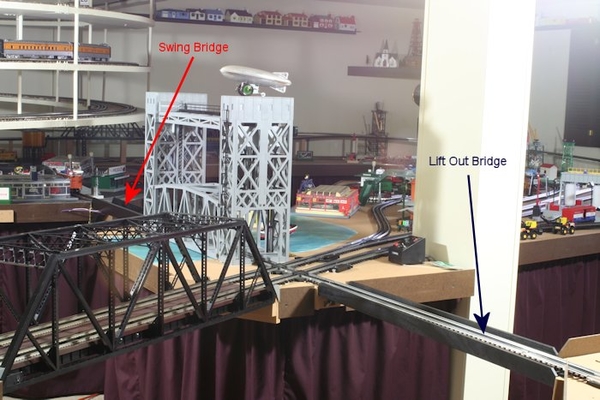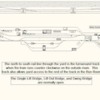What do you design into your benchwork system to accommodate the seasonal expansion and contraction of your wooden benchwork for dependable lift out fit?
Replies sorted oldest to newest
I have a drawbridge that allows access to the center of my layout. The current bridge has been in place for over a year with no issues, and before that a wooden temporary span was in place for about 2.5 years with no issues. Any expansion or contraction has been minimal, but I also keep the climate in my train room fairly consistent year-round.
John
I can attest for JOHN's beautiful bridge. JOHN has a hinged bridge that works great. Can't beat it, and it will save your knees.
Atlas Pratt Truss bridge. Lift out, stores under the bench work.
What is the size of the benchwork in the responses above, small, medium, large, extra large?
Is the benchwork free standing or mounted firmly on the wall?
Two layouts that have caused concern: one is a HO 60' X 3' mounted along a wall with a lift out mid point. Experiences a plus / minus seasonally change at the lift out of 3/8".
The other is a 0 scale 2r 40' X 2' mounted on one wall and 30' X 2' mounted on the other wall with lift outs at the 90 degree inside corner. The over under for this one is 1/4".
Both layouts feature year round 70 degrees & 35% to 50% humidity but each experience these expansion / contraction issues.
Thoughts based on experience?
The Atlas bridge is 40"s, track end to track end. Fits well, may be from Winter to Summer a 1/16" difference. Both bench work ends are solid. Installed a few days ago/hot and humid, tight fit, but it did slip in and out with no trouble. Area is air conditioned.
Tom Tee posted:Thoughts based on experience?
No experience with a layout of that size, but some experience with wood. For what it's worth:
Wood moves much more across the grain than along the grain. Another way of putting it: a board will get wider, but it does not get noticeably longer, though if you have a really long run it could add up.
If you think of how a layout is built, you have plywood supported on boards running perpendicular to the edge of the layout. Since the grain of the support boards is running perpendicular to edge of the layout, that means most of the expansion will be parallel to the edge of the layout. The expanding boards will make your layout get "longer". If your layout is curved, the corners are where it will show, but if it is a straight line, you might see the cumulative expansion all at one end. Probably it is not so much the plywood top that is expanding, as the lumber underneath it. The plywood is along for the ride. (Because plywood has grain running both ways, it can't really expand, so it warps instead.)
Woodworkers make a point of leaving room for expansion whenever they have to join pieces where grain in one is running at 90 degrees to the grain in the other. One simple way to do it on the layout would be to elongate the holes where the plywood is attached to the crossmember, so when the crossmember expands, the plywood will float a little and not follow it. You would only have to do that on one end of the plywood. Another way might be to leave an expansion joint every few feet, so when your layout expands in the humidity, it doesn't push all the way to one end.
The layouts have no lumber as described, only 3/4" hard wood plywood. All support members are fabricated from the 3/4" plywood.
Tom, If the entire layout is constructed out of plywood, legs, framing and deck will there be no expansion problems? Will there be any warping problems? Thanks, Rich
Warping is largely founded in the species and construction of the plywood. Any thickness Pine plywood is a 4 x 8 foot potato chip just waiting to happen.
Three ply 1/2" anything is crating material.
c-c, c-d or even sometimes b-c plywood is not that great..
a-b shop grade maple birch plywood is one of the best bargains in plywood sheeting.
My own layout is being built 90% out of left over material from my layout contracting. Some of the modules are not that pretty due to differing woods but it is going together non the less.
You mention warping. I have some 5 ply 1/2" hardwood plywood from two careers ago (1976) that was stored flat for decades that was just begging to be included in this my last layout. Just installed my last bicentennial piece and it is still as flat as a pane of glass. Performance is determined by a combination of material and skill IME.
One of the largest HO RR which was featured in MR a few years ago is somewhat of a neighbor He has about 3600 square feet of total plywood layout, is about 16 years old, regularly operates with 2 dozen guys and is as fine a pike as one could have.
Recent years I discover Advantech. If you want to save some $$$ over plywood and have a glass flat surface give it a look see. I just installed some more on one of my branch lines. Great stuff!! Rated for 4 months in open weather for home construction.
Solid dimensional lumber can not hold a candle to quality manufactured sheets.
3/4" solid wood t&g flooring is not rated for below grade installations.
Manufactured thin wood flooring IS rated for below grade installations.
What does that say to you about solid wood?
PS: NICKAXI was dead on about wood fibers and expansion. Solid woods expand markedly in their width.
Mike CT posted:Atlas Pratt Truss bridge. Lift out, stores under the bench work.
MikeCT, Brilliant in its simplicity!!!!
Tom Tee posted:Thoughts based on experience?
Tom, my experience is very similar to yours. My tables are 1/2" plywood topped with Homasote on 2 x 4 legs. A 50' track length with one lift out, one swing up, and one swing to side has considerable swelling in the moist summer compared to the dry winter heated area.
The Run Room below is 69' long. The left arrow is the swing up bridge (very small gap variation) with right tables attached to a wall. The second arrow to the the right shows the only lift out bridge with the biggest gaps (split the difference when placing the bridge). That large gap is caused by the free standing tables to the left of the lift out. The table to the right is anchored to the pillar. The right arrow identifies the swing bridge where the electrical contacts were redesigned to allow for expansion of tables to the right.
See the lift out and swing bridges below.
See more info at Access Bridges used as Switches














